动词时态语态一览表
- 格式:doc
- 大小:23.50 KB
- 文档页数:2
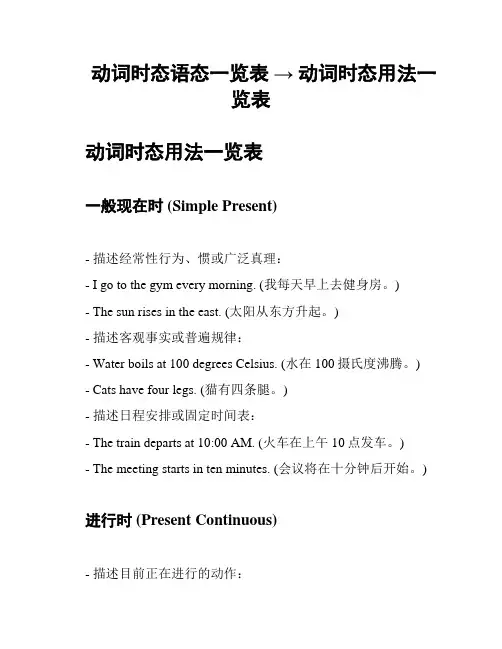
动词时态语态一览表→ 动词时态用法一览表动词时态用法一览表一般现在时 (Simple Present)- 描述经常性行为、惯或广泛真理:- I go to the gym every morning. (我每天早上去健身房。
)- The sun rises in the east. (太阳从东方升起。
)- 描述客观事实或普遍规律:- Water boils at 100 degrees Celsius. (水在100摄氏度沸腾。
) - Cats have four legs. (猫有四条腿。
)- 描述日程安排或固定时间表:- The train departs at 10:00 AM. (火车在上午10点发车。
)- The meeting starts in ten minutes. (会议将在十分钟后开始。
) 进行时 (Present Continuous)- 描述目前正在进行的动作:- She is studying for her exams. (她正在备考。
)- They are playing football in the park. (他们正在公园踢足球。
) - 表示暂时的行为状态:- He's staying at his friend's house for the weekend. (他本周末在朋友家住。
)- I'm working on a project right now. (我现在正在做一个项目。
) 现在完成时 (Present Perfect)- 表示过去发生的动作对当前有影响:- I have finished my homework, so I can watch TV. (我已经完成作业了,所以可以看电视。
)- They have been to Paris several times. (他们已经去过巴黎好几次了。
)- 描述经验或成就:- She has won many awards in her career. (她在她的职业生涯中赢得了许多奖项。
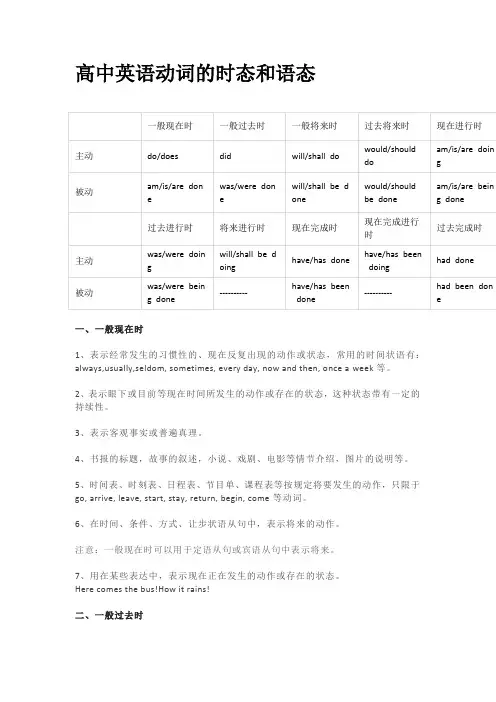
高中英语动词的时态和语态1、表示在过去某一时间点发生的动作或所处的状态,与现在没有关系。
常用的时间状语有:yesterday, last night, at that time等。
2、表示在过去某一段时间里反复出现的动作或状态,与现在没有关系。
3、用used to do或would do表示过去经常或反复发生的动作。
4、有些情况发生的时间没清楚表明,但实际上是“刚才,刚刚”发生的,属于过去时间,应使用过去时态。
常见的有I didn’t know…或I forgot…等。
5、一般过去时可与today, this week, this month等时间状语连用。
三、一般将来时1、will/shall do(1)表示将来会出现的动作或状态。
常用的时间状语:this evening, tomorrow, next week/month…,at the end of this term, in a few minutes等。
(2)表示将来经常发生的动作。
(3)表示事物的固有属性或必然趋势、倾向。
(4)表示说话过程中做出某种决定。
注意:条件状语从句中的will表示“决心,意愿”,此时will是情态动词表示意愿。
2、be going to do(1)表示已经决定或安排要做的事。
(2)表示根据某种迹象认为在最近或将来将要发生的事。
3、be to do(1)表示约定、计划或按职责、义务要求即将发生的动作。
(2)表示说话人的意志、意图、职责、义务、命令。
(3)表示注定要发生的事情。
4、be about to do(1)表示即将发生的动作,意为“正要,即将”。
(2)不可与表示具体的将来时间的副词或副词性短语连用,但可以同由as或when 引导的时间状语从句连用。
5、某些动词的现在进行时表示即将发生的动作。
四、过去将来时1、would/should do表示从过去某一时间来看将要发生的动作或将要存在的状态。
通常用于其主句的谓语为过去时态的宾语从句中。
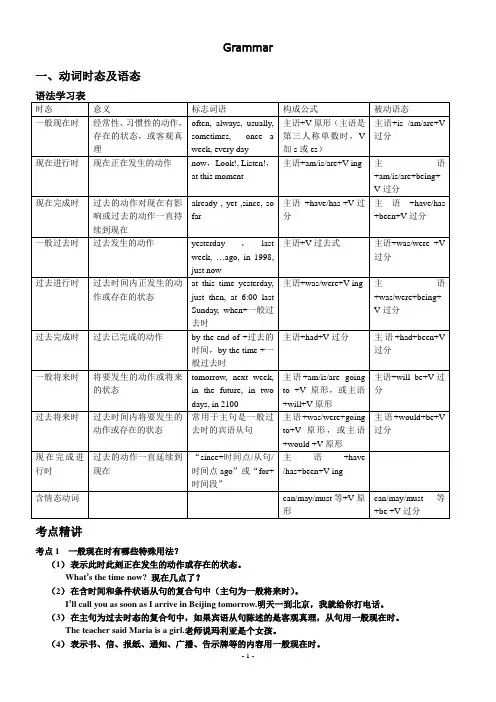
Grammar一、动词时态及语态语法学习表时态意义标志词语构成公式被动语态一般现在时经常性、习惯性的动作,存在的状态,或客观真理often, always, usually,sometimes, once aweek, every day主语+V原形(主语是第三人称单数时,V加s或es)主语+is /am/are+V过分现在进行时现在正在发生的动作now,Look!, Listen!,at this moment 主语+am/is/are+V-ing 主语+am/is/are+being+V过分现在完成时过去的动作对现在有影响或过去的动作一直持续到现在already , yet ,since, sofar主语+have/has +V过分主语+have/has+been+V过分一般过去时过去发生的动作yesterday ,lastweek, …ago, in 1998,just now 主语+V过去式主语+was/were +V过分过去进行时过去时间内正发生的动作或存在的状态at this time yesterday,just then, at 6:00 lastSunday, when+一般过去时主语+was/were+V-ing 主语+was/were+being+V过分过去完成时过去已完成的动作by the end of +过去的时间,by the time +一般过去时主语+had+V过分主语+had+been+V过分一般将来时将要发生的动作或将来的状态tomorrow, next week,in the future, in twodays, in 2100主语+am/is/are goingto +V原形,或主语+will+V原形主语+will be+V过分过去将来时过去时间内将要发生的动作或存在的状态常用于主句是一般过去时的宾语从句主语+was/were+goingto+V原形,或主语+would +V原形主语+would+be+V过分现在完成进行时过去的动作一直延续到现在“since+时间点/从句/时间点ago”或“for+时间段”主语+have/has+been+V-ing含情态动词can/may/must等+V原形can/may/must等+be +V过分考点精讲考点1 一般现在时有哪些特殊用法?(1)表示此时此刻正在发生的动作或存在的状态。

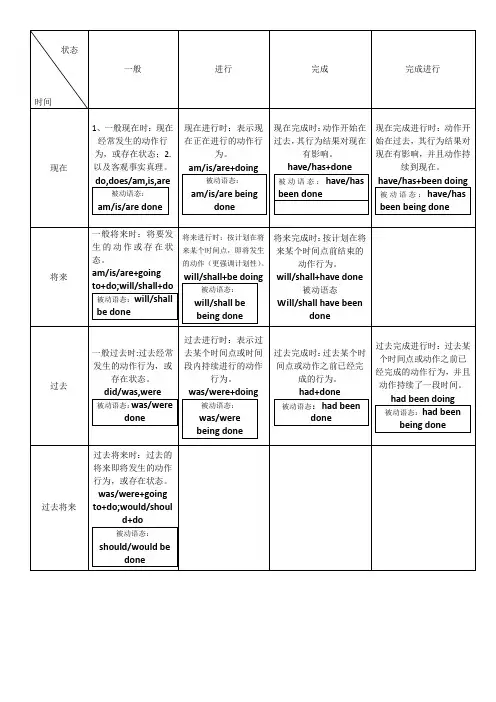
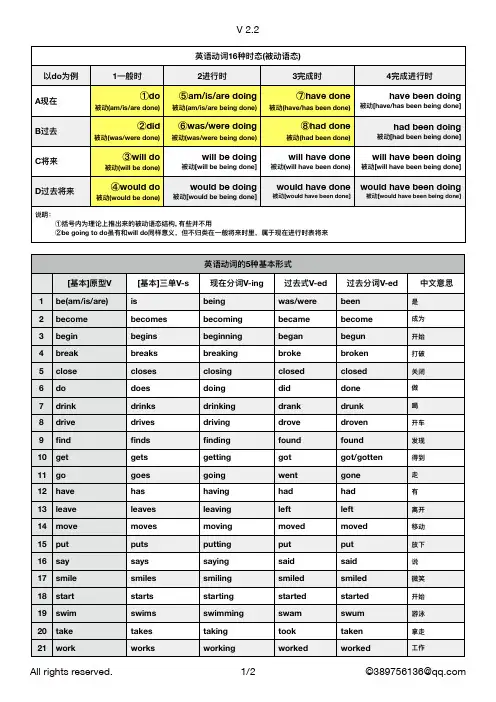
英语动词16种时态(被动语态)以do为例例1⼀一般时2进⾏行行时3完成时4完成进⾏行行时A现在①do被动(am/is/are done)⑤am/is/are doing被动(am/is/are being done)⑦have done被动(have/has been done)have been doing被动[have/has been being done]B过去②did被动(was/were done)⑥was/were doing被动(was/were being done)⑧had done被动(had been done)had been doing被动[had been being done]C将来③will do被动(will be done)will be doing被动[will be being done]will have done被动(will have been done)will have been doing被动[will have been being done]D过去将来④would do被动(would be done)would be doing被动[would be being done]would have done被动[would have been done]would have been doing被动[would have been being done]说明:①括号内为理理论上推出来的被动语态结构, 有些并不不⽤用②be going to do虽有和will do同样意义,但不不归类在⼀一般将来时⾥里里,属于现在进⾏行行时表将来英语动词的5种基本形式[基本]原型V[基本]三单V-s现在分词V-ing过去式V-ed过去分词V-ed中⽂文意思1be(am/is/are)is being was/were been是2become becomes becoming became become成为3begin begins beginning began begun开始4break breaks breaking broke broken打破5close closes closing closed closed关闭6do does doing did done做7drink drinks drinking drank drunk喝喝8drive drives driving drove droven开⻋车9findfindsfinding found found发现10get gets getting got got/gotten得到11go goes going went gone⾛走12have has having had had有13leave leaves leaving left left离开14move moves moving moved moved移动15put puts putting put put放下16say says saying said said说17smile smiles smiling smiled smiled微笑18start starts starting started started开始19swim swims swimming swam swum游泳20take takes taking took taken拿⾛走21work works working worked worked⼯工作英语16种动词时态例例句句(以do为例例)A1(⼀一般)现在present simple①I do my homework everyday.②China is a big country.A2现在进⾏行行present continuous①I am doing my homework now.②She is drinking water now.A3现在完成present perfect①I have done my homework. (I’m done with it. Now I can go out.)②I have waited for you for 2 hours. (Now you are here. Let’s go)A4现在完成进⾏行行present perfect continuous①I have been doing my homework for a long time.(I’m not donewith it. I have to keep doing it for another 2 two hours.)②I have been waiting for you for 2 hours. (You’re still on your way. Ihave to keep waiting for another 2 hours.)B1(⼀一般)过去past simple①I did my homework yesterday.②Japan invaded China in World War II.B2过去进⾏行行past continuous①I was doing my homework this time yesterday.B3过去完成past perfect①I told my mum that I had done my homework. (Then I went outfor a walk with my friend.)B4过去完成进⾏行行past perfect continuous①By the time my mum arrived home, I had been doing myhomework for 2 hours. ( But I wasn’t done. I had to keep doing itfor one more hour.)C1(⼀一般)将来future simple①I will do my homework tomorrow. (I don’t want to do it now.)C2将来进⾏行行future continuous①I will be doing my homework this time tomorrow. (Don’t call meout.)②I will be sleeping at 6:00 am tomorrow, so don’t call me. (I don’twant to be disturbed.)C3将来完成future perfect①I will have done my homework at 3:00 pm. (According to my plan,I can finish it at 3:00 pm this afternoon. So we can go to the parkand relax.)C4将来完成进⾏行行future perfect continuous①I will have been doing my homework for 2 hours by 3:00 pm. (AndI have to spend 1 more hour to finish it. I’ll finish it at 4:00 pm.D1(⼀一般)过去将来future simple in the past①I said I would do my homework after the class. (I promised myteacher)D2过去将来进⾏行行future continuous in the past①I said I would be doing my homework at 10:00 pm. (By that time,I would be doing my homework.)D3过去将来完成future perfect in the past①I promised I would have done my homework before going to bed.(My homework would be done before I went to bed.)D4过去将来完成进⾏行行future perfectcontinuous in the past①I said I would have been doing my homework for 2 hours by10:00 pm.。

英语语法:动词的时态和语态语态和时态学习英语的两大基础,是构成英语句型的关键,掌握了它们就为学好英语打下了坚实的基础。
所以用时必须熟练而准确。
小编在这里整理了相关知识,快来学习学习吧!一、一般现在时1、表示经常发生的习惯性的、现在反复出现的动作或状态,常用的时间状语有:always,usually,seldom, sometimes, every day, now and then, once a week 等。
2、表示眼下或目前等现在时间所发生的动作或存在的状态,这种状态带有一定的持续性。
3、表示客观事实或普遍真理。
4、书报的标题,故事的叙述,小说、戏剧、电影等情节介绍,图片的说明。
5、时间表、时刻表、日程表、节目单、课程表等按规定将要发生的动作,只限于 go, arrive, leave, start, stay, return, begin, come 等动词。
6、在时间、条件、方式、让步状语从句中,表示将来的动作。
注意:一般现在时可以用于定语从句或宾语从句中表示将来。
7、用在某些表达中,表示现在正在发生的动作或存在的状态。
Here comes the bus!How it rains!二、一般过去时等1、表示在过去某一时间点发生的动作或所处的状态,与现在没有关系。
常用的时间状语有:yesterday, last night, at that time 等。
2、表示在过去某一段时间里反复出现的动作或状态,与现在没有关系。
3、用 used to do 或would do 表示过去经常或反复发生的动作。
4、有些情况发生的时间没清楚表明,但实际上是“刚才,刚刚”发生的,属于过去时间,应使用过去时态。
常见的有 I didn’t know…或 I forgot…等。
5、一般过去时可与 today, this week, this month 等时间状语连用。
三、一般将来时1、will/shall do(1)表示将来会出现的动作或状态。
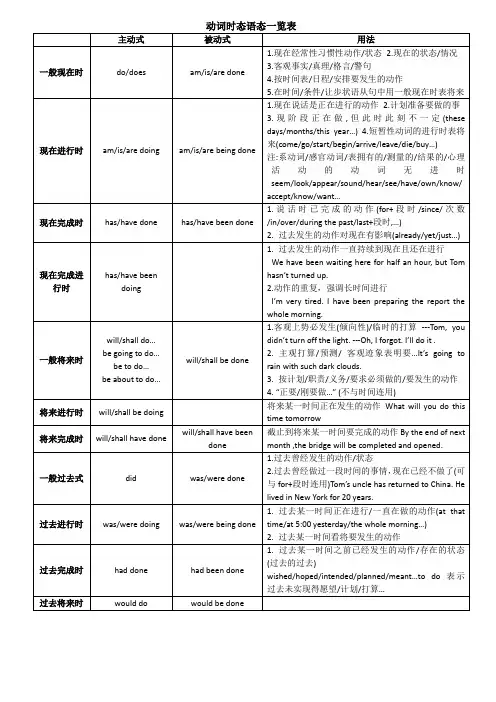
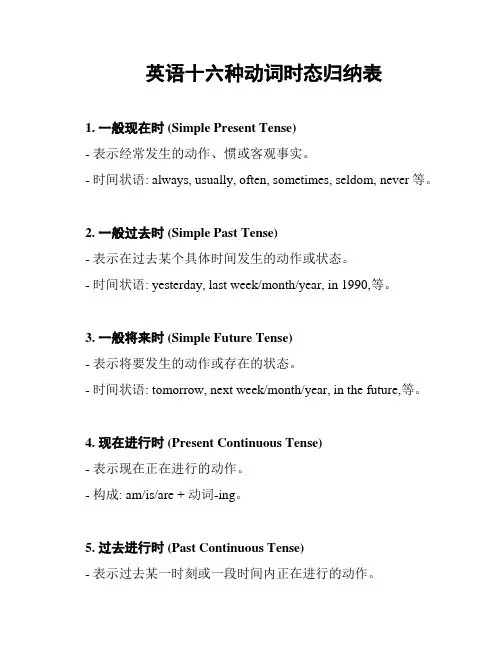
英语十六种动词时态归纳表1. 一般现在时 (Simple Present Tense)- 表示经常发生的动作、惯或客观事实。
- 时间状语: always, usually, often, sometimes, seldom, never等。
2. 一般过去时 (Simple Past Tense)- 表示在过去某个具体时间发生的动作或状态。
- 时间状语: yesterday, last week/month/year, in 1990,等。
3. 一般将来时 (Simple Future Tense)- 表示将要发生的动作或存在的状态。
- 时间状语: tomorrow, next week/month/year, in the future,等。
4. 现在进行时 (Present Continuous Tense)- 表示现在正在进行的动作。
- 构成: am/is/are + 动词-ing。
5. 过去进行时 (Past Continuous Tense)- 表示过去某一时刻或一段时间内正在进行的动作。
- 构成: was/were + 动词-ing。
6. 将来进行时 (Future Continuous Tense)- 表示将来某一时刻或一段时间内正在进行的动作。
- 构成: will be + 动词-ing。
7. 现在完成时 (Present Perfect Tense)- 表示动作对现在造成的影响或状态。
- 构成: have/has + 过去分词。
8. 过去完成时 (Past Perfect Tense)- 表示在过去某一时间点或动作之前已经发生的动作。
- 构成: had + 过去分词。
9. 将来完成时 (Future Perfect Tense)- 表示在将来某一时间点之前将会发生的动作。
- 构成: will have + 过去分词。
10. 现在完成进行时 (Present Perfect Continuous Tense)- 表示从过去某一时刻开始一直延续到现在且可能继续下去的动作或状态。
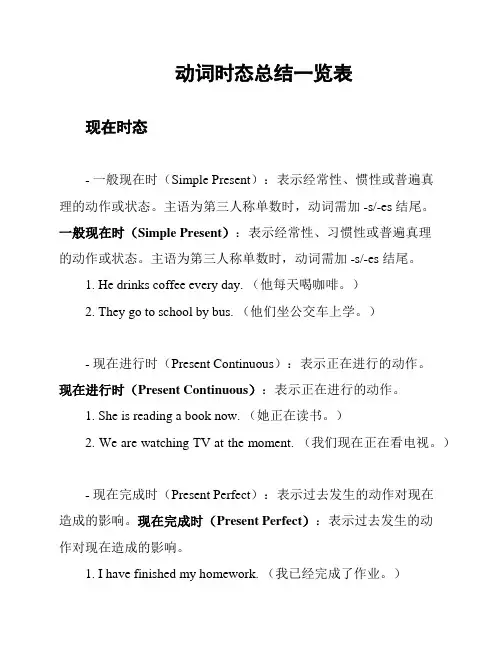
动词时态总结一览表现在时态- 一般现在时(Simple Present):表示经常性、惯性或普遍真理的动作或状态。
主语为第三人称单数时,动词需加 -s/-es 结尾。
一般现在时(Simple Present):表示经常性、习惯性或普遍真理的动作或状态。
主语为第三人称单数时,动词需加 -s/-es 结尾。
1. He drinks coffee every day. (他每天喝咖啡。
)2. They go to school by bus. (他们坐公交车上学。
)- 现在进行时(Present Continuous):表示正在进行的动作。
现在进行时(Present Continuous):表示正在进行的动作。
1. She is reading a book now. (她正在读书。
)2. We are watching TV at the moment. (我们现在正在看电视。
)- 现在完成时(Present Perfect):表示过去发生的动作对现在造成的影响。
现在完成时(Present Perfect):表示过去发生的动作对现在造成的影响。
1. I have finished my homework. (我已经完成了作业。
)2. They have lived here for two years. (他们在这里住了两年了。
)- 现在完成进行时(Present Perfect Continuous):表示动作从过去一直延续到现在。
现在完成进行时(Present Perfect Continuous):表示动作从过去一直延续到现在。
1. They have been playing basketball for two hours. (他们已经打了两个小时的篮球了。
)2. I have been studying English for five years. (我已经研究英语五年了。
)过去时态- 一般过去时(Simple Past):表示过去某个时间发生的动作或状态。
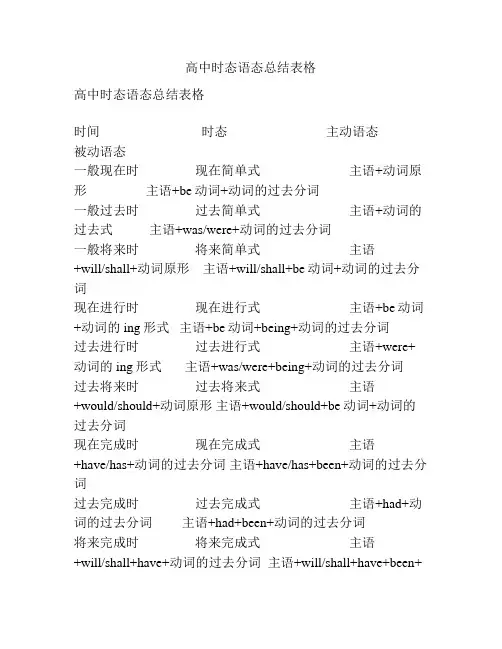
高中时态语态总结表格高中时态语态总结表格时间时态主动语态被动语态一般现在时现在简单式主语+动词原形主语+be动词+动词的过去分词一般过去时过去简单式主语+动词的过去式主语+was/were+动词的过去分词一般将来时将来简单式主语+will/shall+动词原形主语+will/shall+be动词+动词的过去分词现在进行时现在进行式主语+be动词+动词的ing形式主语+be动词+being+动词的过去分词过去进行时过去进行式主语+were+动词的ing形式主语+was/were+being+动词的过去分词过去将来时过去将来式主语+would/should+动词原形主语+would/should+be动词+动词的过去分词现在完成时现在完成式主语+have/has+动词的过去分词主语+have/has+been+动词的过去分词过去完成时过去完成式主语+had+动词的过去分词主语+had+been+动词的过去分词将来完成时将来完成式主语+will/shall+have+动词的过去分词主语+will/shall+have+been+动词的过去分词以上是高中时态语态的总结表格,总结了不同的时态和语态的构成形式。
下面将对每个时态和语态进行解读和举例说明。
一般现在时:- 构成形式:主语 + 动词原形- 用法:表示经常性、习惯性的动作,客观事实等。
- 例句:I play basketball every Saturday.(我每个星期六打篮球。
)一般过去时:- 构成形式:主语 + 动词的过去式- 用法:表示过去某个时间发生的动作或存在的状态。
- 例句:She visited her grandparents last week.(她上周去看望了她的祖父母。
)一般将来时:- 构成形式:主语 + will/shall + 动词原形- 用法:表示将来某个时间要发生或存在的动作或状态。
- 例句:I will finish my homework before dinner.(我会在晚饭前完成作业。
英语动词时态归纳总结对照表英语时态专项练习1、一般现在时。
通常用“usually, often, every day, sometimes”。
一般现在时基本用法介绍一、一般现在时的功能1.表示事物或人物的特征、状态。
如:The sky is blue.天空是蓝色的。
2.表示经常性或习惯性的动作。
如:I get up at six every day.我每天六点起床。
3.表示客观现实。
如:The earth goes around the sun.地球绕着太阳转。
二、一般现在时的构成:肯定句:1).主语+系动词 be(is, am, are )+名词(形容词,介词短语)2) .其他主语+动词原形+其它第三人称单数+动词-s+其它如:I am a boy.我是一个男孩。
We study English.我们学习英语。
Mary likes Chinese.玛丽喜欢汉语。
三、一般现在时的变化否定句:1)主语+ be (is,am,are)+ not +其它。
如:He is not a worker.他不是工人。
2)其他主语+do not(don’t)动词原形+其它I don't like bread第三人称单数+does not(doesn’t)动词原形+其它He doesn't often play.一般疑问句:1)Be(Is,Are) +主语+其它?如:-Are you a student? -Yes. I am. / No, I'm not.2)Do其他主语+动词原形+其它?Does+第三人称单数+动词原形+其它+?注意:遇I/we—you, my—your, some—any.Does she go to work by bike? - Yes, she does. / No, she doesn't.Do you often play football?- Yes, I do. / No, I don't.特殊疑问句:疑问词+一般疑问句。
语法复习专题八动词的时态、语态I、时态重点难点解析高考中通常是把时态和语境结合起来考查。
题干中往往没有明确的时间状语,需要考生搜索出时间参照信息。
英语有16种时态,中学阶段常用的是10种。
一、动词的基本形式一览表1. 一般过去时和现在完成时1)一般过去时只表示过去发生的动作或状态,常和表过去的时间状语连用,即仅谈过去,不关现在。
I wrotea letter this morning. (只说明写了一封信的事实)2)现在完成时表示过去发生的动作或状态,但和现在有联系,可能刚结束,也可能继续下去。
不能和表过去的时间状语连用,译成汉语时可加“已经”。
I have written a letter this morning. (我已经写了一封信,有继续写第二封的可能,现在还是早上。
)2. 一般过去时和过去进行时1)一般过去时侧重于说明发生某动作的事实。
It rained heavily last night.昨晚雨下得很大。
(强调下雨,并不强调持续时间)2)过去进行时侧重于强调某动作的持续过程或表示动作在进行。
It was raining cats and dogs last night昨晚整整一夜都在下倾盆大雨。
(强调没停,一直持续)3. 现在完成时和现在完成进行时1) 现在完成时在含义上着重表示动作的结果。
I have read that book. (已读完)2)现在完成进行时着重表示动作一直在进行,即动作的延续性。
I have been reading that book all the morning.( 还没读完)注:It is/was +时间段since从句(从句的谓语动词如果是持续性动词:表示自从某人不做某事已多久了:It is/was +时间段since从句(从句的谓语动词如果是短暂性动词:表示自从某人做某事以来已多久了:Eg: It is ten years since he came here. 他来这儿已10年了。
谓语动词的时态和语态动词的时态和语态英语的时态是一种动词形式.不同的时态用以表示不同的时间与方式.英语动词有16种时态,常用的有8种:一般现在时、一般过去时、一般将来时、过去将来时、现在进行时、过去进行时、现在完成时、过去完成时。
但高中学生需要了解13种,除了以上8种,还须掌握以下5种:将来进行时(一般将来进行时、过去将来进行时)、一般将来完成时、完成进行时(现在完成进行时、过去完成进行时)。
下面分别介绍。
16种时态形式(以do为例):现在过去将来过去将来一般现在一般时do过去一般时did将来一般时will do过去将来一般时would do完成目前完成时have done过去完成时had done将来完成时will have done 举行目前举行时is doing曩昔举行时was doing将来举行时will be doing完成举行现在完成进行时have been doing曩昔完成举行时had been doing将来完成进行时will have been doing过去将来完成进行时wouldhave been doing过去将来完成时过去将来进行时would have donewould be doing【注】构成时态的助动词be (is, am, are), have (has), shall, will等需根据主语的变化来选.一.一般现在时1).表示经常性或习惯性的动作或状态.常与表示频度的时间状语连用.如:often,usually,always, sometimes, now, seldom, now and then, every day, occasionally等.I usually leave home for school at 7 every morning.We have meals three times a day.He is always ready to help others.2).表示客观事实、普遍真理、谚语、格言、警句。
动词的时态和语态一、一般现在时1、表示经常发生的习惯性的、现在反复出现的动作或状态,常用的时间状语有:always,usually,seldom, sometimes, eve ry day, now and then, once a week等。
2、表示眼下或目前等现在时间所发生的动作或存在的状态,这种状态带有一定的持续性。
3、表示客观事实或普遍真理。
4、书报的标题,故事的叙述,小说、戏剧、电影等情节介绍,图片的说明等。
5、时间表、时刻表、日程表、节目单、课程表等按规定将要发生的动作,只限于go, arrive, leave, start, stay, return, begin, come等动词。
6、在时间、条件、方式、让步状语从句中,表示将来的动作。
注意:一般现在时可以用于定语从句或宾语从句中表示将来。
7、用在某些表达中,表示现在正在发生的动作或存在的状态。
Here comes the bus!How it rains!二、一般过去时1、表示在过去某一时间点发生的动作或所处的状态,与现在没有关系。
常用的时间状语有:yesterday, last night, at that time等。
2、表示在过去某一段时间里反复出现的动作或状态,与现在没有关系。
3、用used to do或would do表示过去经常或反复发生的动作。
4、有些情况发生的时间没清楚表明,但实际上是“刚才,刚刚”发生的,属于过去时间,应使用过去时态。
常见的有I didn’t know…或I forgot…等。
5、一般过去时可与today, this week, this month等时间状语连用。
三、一般将来时1、will/shall do(1)表示将来会出现的动作或状态。
常用的时间状语:this evening, tomorrow, next week/month…,at the end of this term, in a few minute s等。
英语动词时态表一、一般现在时:概念:经常、反复发生的动作或行为及现在的某种状况。
时间状语:always, usually, often, sometimes, every week (day, year, month…), once a week, etc.基本结构:①be动词;②行为动词否定形式:①am/is/are+not;②此时态的谓语动词若为行为动词,则在其前加don't,如主语为第三人称单数,则用doesn't,同时还原行为动词。
一般疑问句:①把be动词放于句首;②用助动词do提问,如主语为第三人称单数,则用does,同时,还原行为动词。
二、一般过去时:概念:过去某个时间里发生的动作或状态;过去习惯性、经常性的动作、行为。
时间状语:ago, yesterday, the day before yesterday, last week(year, night, month…), in 1989, just now, at the age of 5, one day, long long ago, once upon a time, etc.基本结构:①be动词;②行为动词否定形式:①was/were+not;②在行为动词前加didn't,同时还原行为动词。
一般疑问句:①was或were放于句首;②用助动词do的过去式did 提问,同时还原行为动词。
三、现在进行时:概念:表示现阶段或说话时正在进行的动作及行为。
时间状语:now, at this time, these days, etc.基本结构:am/is/are+doing否定形式:am/is/are+not+doing.一般疑问句:把be动词放于句首。
四、过去进行时:概念:表示过去某段时间或某一时刻正在发生或进行的行为或动作。
时间状语:at this time yesterday, at that time或以when引导的谓语动词是一般过去时的时间状语等。